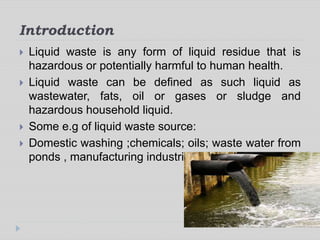How Reclaim Waste can Save You Time, Stress, and Money.
Table of ContentsWhat Does Reclaim Waste Do?The Reclaim Waste StatementsThe 6-Minute Rule for Reclaim WasteReclaim Waste Can Be Fun For EveryoneReclaim Waste Can Be Fun For Everyone
Discover the types, incidents, and kinds of liquid waste. Domestic sewer waste refers to the waste and items from a domestic septic system. This kind of waste is developed by human beings in houses, schools, and various other buildings. This only includes septic systems that have a drain field. The correct administration and disposal of residential sewer waste need fluid waste to be moved to a sewer therapy plant where the appropriate approaches and equipment are used to detoxify and dispose of waste.
Commercial waste usually includes prospective risks, such as combustible materials or a blend of liquid and solid waste items, and needs an advanced and thorough disposal process. The disposal of industrial waste commonly involves the filtration of waste prior to transport to make certain safe and appropriate disposal. Hazardous waste is developed from byproducts and overflow of industrial processes and production.
This type of waste can not make use of the same sewer administration transport or procedures as septic or commercial liquids. The industrial waste administration process requires the evaluation and screening of fluid waste before it undergoes the disposal process (liquid waste disposal melbourne). Runoff waste is the fluid waste that originates from drainage and excess stormwater in very booming locations or cities
Drainage waste can trigger contamination and flooding otherwise taken care of properly. Discover more regarding sewer cleansing and waste management. Ensuring proper waste monitoring can protect against calamities and minimize ecological injury. Both people in residential settings and specialists in industrial or production industries can take advantage of comprehending the processes and laws of liquid waste monitoring.
The Main Principles Of Reclaim Waste
Call PROS Services today to discover our waste administration and disposal services and the proper methods to look after the fluid waste you create.
(https://giphy.com/channel/reclaimwaste1)Do you recognize what happens to your water when you disengage, flush the bathroom or drain the cleaning maker? No? Well, it deserves knowing. This so-called 'wastewater' is not only a vital source however, after treatment, will certainly be released to our land, waterways or the sea. Utilized water from toilets, showers, baths, cooking area sinks, laundries and industrial processes is called wastewater.

water utilized to cool equipment or tidy plant and devices). Stormwater, a form of wastewater, is overflow that moves from farming and urban locations such as roofing systems, parks, yards, roads, courses and gutters right into stormwater drains pipes, after rain. Stormwater streams untreated straight to neighborhood creeks or rivers, eventually reaching the sea.
Reclaim Waste - The Facts
In Queensland, the majority of wastewater is treated at sewage treatment plants. Wastewater is transported from domestic or industrial sites through a system of drains and pump terminals, understood as sewage reticulation, to a sewer treatment plant. City governments develop, preserve and run most sewage therapy plants. Operators are licensed under the Environmental Defense Act 1994 to release cured wastewater at an appropriate ecological criterion into waterways.
The Division of Natural Resources suggests city governments regarding handling, operating and keeping sewerage systems and treatment plants. In unsewered locations, city governments may need owners to set up specific or house sewage treatment systems to deal with domestic wastewater from toilets, kitchens, bathrooms and laundries. The Division of Natural Resources authorises making use of household systems when they are proven to be reliable.
In some new subdivisions, therapy of some stormwater to remove clutter, sand and gravel has started utilizing gross toxin catches. Wastewater therapy happens in 4 stages: Removes strong matter.
Wastewater after that streams right into large containers where solids work out and are gotten rid of as sludge. Grease and residue are skimmed from the surface area. Utilizes little living organisms referred to as micro-organisms to damage down and remove staying liquified wastes and great particles. Micro-organisms and wastes are integrated in the sludge. Gets rid of nitrogen and phosphorus nutrients that could create algal blossoms in our waterways and threaten water life.
The 45-Second Trick For Reclaim Waste
Nutrient elimination is not readily available in all sewer therapy plants because it requires pricey specialised equipment. It is becoming much more common in Queensland. Clear find more info liquid effluent created after treatment may still include disease-causing micro-organisms. If this effluent is released into rivers such as rivers or the sea, the micro-organisms will ultimately pass away out.

Most wastewater flows right into the sewage system. Under the Act, regional federal governments provide authorizations and licences for ecologically relevant tasks (ERAs) involving wastewater launches that may have a local effect.
Reclaim Waste Can Be Fun For Anyone
Or else, samples are considered research laboratory analysis. Commonly several examinations are needed to establish the levels of each of the different contaminants such as oils, hefty steels and pesticides in water. Monitoring supplies valid information concerning water quality and can confirm that licence problems are being met. The information obtained through surveillance offers the basis for making water quality decisions.